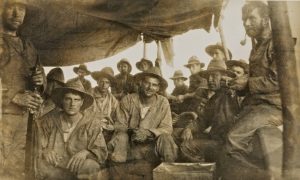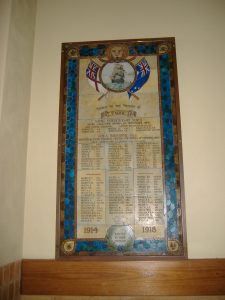- Author
- A.N. Other
- Subjects
- Biographies and personal histories, History - WW1
- Tags
-
- RAN Ships
- HMAS Berrima
- Publication
- December 2014 edition of the Naval Historical Review (all rights reserved)
By Leyland Wilkinson
On a recent visit to the Bita Paka War Cemetery near Rabaul I came across a single headstone to the memory of Able Seaman Herbert Charles Willans, located amongst the grave sites belonging to members of the Australian Naval and Military Expeditionary Force (ANMEF) who lost their lives in Papua New Guinea during WW I.
As Willans is not a common name, enquiries were made into the background of this seaman, the circumstances of his death and interment in this final resting place. Initially it was thought the person was probably Able Seaman B.W. Williams RANR, who was killed in action to capture the German wireless station at Bita Paka on 11 September 1914 and is remembered amongst the first Australian casualties of WW I. However, further research eventually brought to light the story of Able Seaman H.C. Willans, firstly with the assistance of the Australian Gazetteof 18 May 1915 which recorded much of his important information. From these details the National Archives at Kew provided his original Royal Navy service record and the Australian War Memorial inCanberra had details of his entry into the Royal Australian Navy.
Herbert Charles Willans was born on 27 May 1888 at Cardiff, Glamorgan. He enlisted in the Royal Navy on 31 October 1904, aged 16. His previous occupation was listed as ‘errand boy.’ His Royal Naval Official Number 232899 indicated his rating as a member of the Communications/Signal Branch. He was sent for initial training to HMS Impregnableand later HMS Lion, both old converted ships-of-the-line based at Devonport. After a relatively short period of service he was discharged — invalided.
It has not been established how he came to Australia but 1914 found him in Adelaide, where he had registered in the Naval Reserve. On 4 August 1914 war was declared and a few days later, on the 14thof that month, an article appeared in the Adelaide Registercalling for volunteers from those seamen who had previously registered their names. That same day Willans presented himself for selection and medical examination at the Naval Depot Largs, Port Adelaide where he was accepted and became Able Seaman Willans, Serial No. 369, Royal Australian Naval Reserve.
The following day he was sent with the South Australian quota of Naval Reservists to Williamstown Naval Depot in Port Melbourne where they joined around 100 of the Victorian group of seamen who had been similarly recruited. This combined group then left Melbourne by a special train on 17 August bound for Sydney, where they arrived the following day.
After assembling at Sydney Central Railway Station, they marched through the city streets to Man’o’War Steps, a small wharf adjacent to where the Sydney Opera House now stands. Here they boarded harbour ferries and were taken up river to Cockatoo Island Dockyard. Finally they embarked aboard a converted P&O passenger liner which had been hurriedly commissioned for war service as the Armed Merchant Cruiser HMAS Berrima.
The forward part of the vessel was set up to accommodate 600 naval reservists, and around 1,000 troops were quartered aft. They were now all part of the Australian Naval & Military Expeditionary Force (ANMEF), with A.B. Willans listed amongst No. 6 Company RANR, mainly of men from South Australia, whilst Companies 1, 2 and 3 were from New South Wales and Queensland and 4 and 5 Companies were Victorians.
Early the following morning Berrima,proudly flying the White Ensign, left Cockatoo Island, moved down harbour and by noon on Wednesday 19 August 1914 they were underway amidst the sounds of cheering crowds gathered around the foreshores. They departed under sealed orders with the likes of Herbert Willans unaware of where they were bound. The fledgling Australian Navy had been ordered north to help search for and destroy the German naval East Asiatic Squadron and also to destroy their radio communication stations, strategically sited on various islands throughout their Pacific colonies.
Berrima sailed north via Moreton Bay (Brisbane) where she rendezvoused with HMAS Sydney before proceeding to Palm Island, just north of Townsville. Here the troops received special training in tropical warfare. The naval parties were busily engaged in manning the ship’s boats, transporting troops and equipment each day and gaining experience on coming ashore on both sandy beaches and rocky headlands.
After a busy week of training everyone and their equipment returned to the ship. Sunday morning Chaplain Vivian Little from Sydney conducted church parade. He later noted: ‘The troop ship appeared to be well ordered, in good condition, clean and properly fitted up. Below in what is usually cargo space, mess tables have been fitted in, and all the necessary fittings made, rough and ready, but still serviceable. There appeared to be a scarcity of comforts, even for the officers, probably due to the haste of which the expedition was formed.’ After the church service most of the Naval Reservists were given shore leave, as they had done such good work during the week, using the only seven boats and one motor launch available to ferry everyone and everything between ship and shore.

On 2 September Berrima was joined by the Australian submarines AE1 and AE2 and in company with the cruisers Sydney and HMAS Encounter made their way inside the Barrier Reef to Port Moresby, where they all coaled and oiled. At Port Moresby many of the Naval Reservists were transferred from Berrima to Sydney. When this was completed the assembled ships left Port Moresby and proceeded easterly to Rossel Island for a planned rendezvous with the remainder of the squadron and the flagship the battlecruiser HMAS Australia.
With plans finalised preparations were in place for the attack on German New Guinea. The men were in high spirits, despite the tropical heat being severely felt in their crowded quarters. The sailors’ working dress was of canvas and their main clothing and uniforms were of wool which became almost intolerable in the warm moist climate – many took the opportunity to make their attire more suitable to tropical conditions. Colonel Holmes1 wrote from aboard Berrima, when only 300 miles (480 km) from their destination: ‘There is a most excellent feeling on board, the discipline is of the best, food is good, and there is not a single case in hospital.’

As dawn broke on Friday 11 September they steamed through St George’s Channel, rounded Cape Gazelle and came to Herbertshohe (Kokopo) and anchored a short distance off shore. Here Sydney transferred many of her Naval Reservists to the attendant destroyers. The ANMEF had reached enemy territory at last, having taken 24 days to cover the 1,965 miles (3,162 km) from Sydney.
The destroyers HMA Ships Warrego and Yarra were first to arrive inshore and quickly landed most of their Reservists at Kabakaul, with the object of capturing the German wireless station, situated about 5 miles (8 km) distant. They were met by heavy opposition shortly after leaving the coastline as they made their way along this narrow bush road, lined on both sides by dense tropical vegetation. The German-led native troops had entrenched themselves at a bend in the road, and it was here that the naval party were ambushed, fired upon from both trench, treetops and surrounding bush.
Reinforcements were hurriedly called for and they were then able to overcome the defenders. Then pushing ahead along the track they faced and silenced further enemy resistance. Ultimately by about 1900 that evening the wireless station was in the hands of the Australians. This day’s action cost the lives of seven Australians with a further five wounded, the Germans lost one killed and one wounded but the native troops fared far worse with 30 killed and 10 wounded. These casualties were Australia’s first losses in the Great War, with their names recorded and remembered on memorials at Garden Island Naval Dockyard Chapel, at St Mark’s Chapel HMAS Cerberus and the National War Memorial in Canberra.

While the name of Able Seaman Willans is also listed on these memorials he did not die during the Battle of Bita Paka; he died at Rabaul three months later, on 24 December 1914. The cause of his death was recorded as ‘malignant malaria with complications.’ It appears that Herbert Willans had been temporarily posted as part of a steaming crew to the captured German prize SMS Komet when she was taken south to Sydney. The ship was quickly converted to naval use and returned to New Guinea with Able Seaman Willans a member of her crew – a number of the crew are known to have contracted malaria.
His original gravesite was in the old Rabaul Cemetery. This was severely damaged and desecrated during the Japanese occupation in 1942. When the Bita Paka War Cemetery was established in 1950, the remains of those servicemen buried at Rabaul and Kokopo were recovered and re-interred at the new site. The cemetery grounds, which are beautifully maintained, are located in the area of the old German wireless station, a peaceful setting now, but which a century past had been the cause of the RAN’s first casualties of war. Here lie the remains of 32 Commonwealth servicemen from WW I and 1,120 from WW II. We might spare a moment to reflect upon the fate of the young man from Cardiff who came to Adelaide to start a new life – within days of war being declared he had volunteered for service and as an ex sailor was readily accepted. He was to pay the ultimate sacrifice in far distant German New Guinea a place almost certainly completely unknown to him and his family.
Note:
- Colonel William Holmes, CMG, DSO, VD (1862-1917) commanded the ANMEF at New Guinea (1914–1915) and later as a Major General was killed in action in Flanders July 1917.




